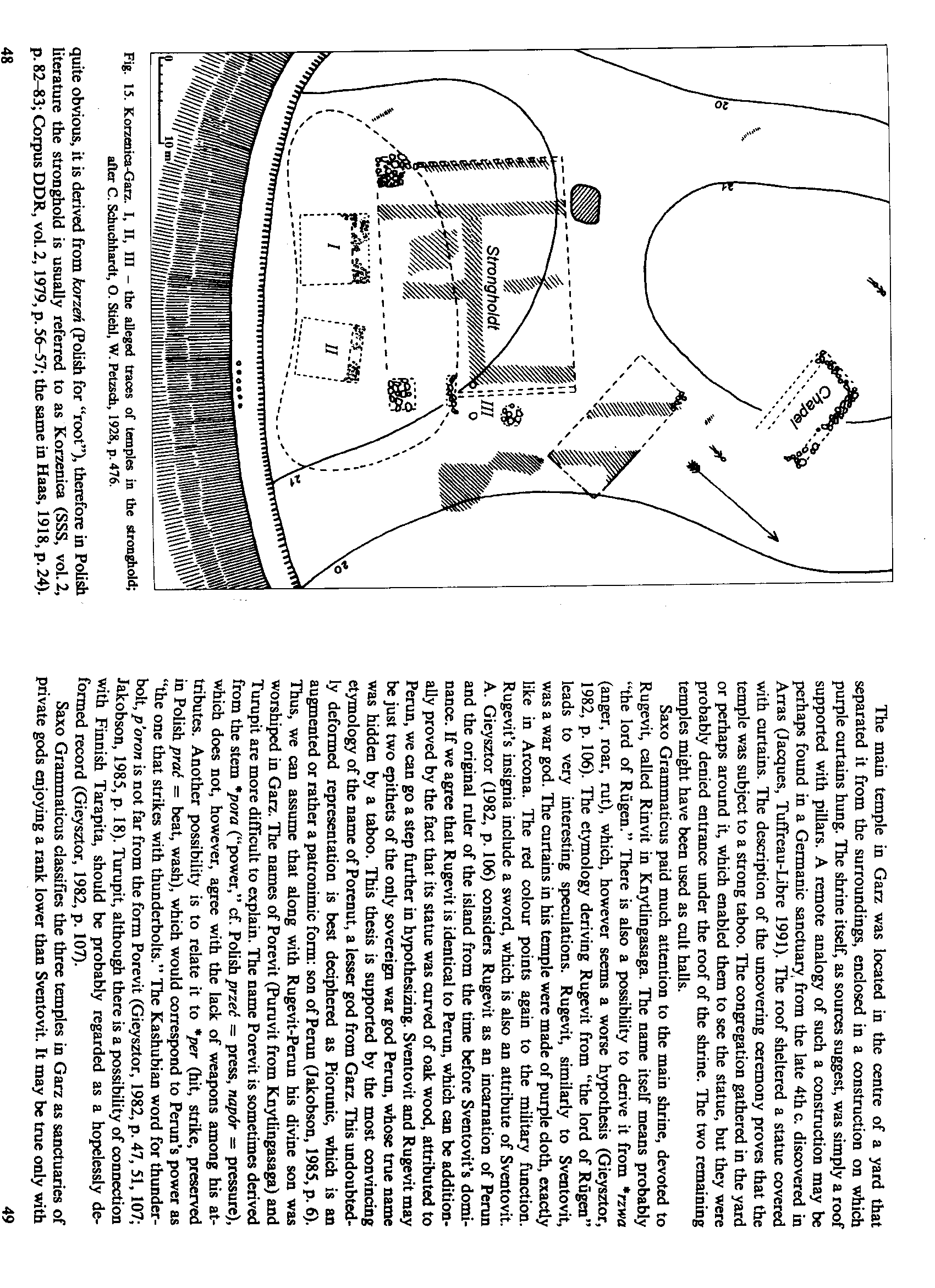image023


Fig. 15. Korzenica-Garz. I, II, m - the alleged traces of temples in the stronghold; after C. Schuchhardt, O. Stiehl, W. Petzsch, 1928, p. 476.
quite obvious, it is deriyed front korzeń (Poiish for “root”), therefore in Polish literaturę the stronghold is usually referred to as Korzenica (SSS, vol.2, p. 82-83; Corpus DDR, vol. 2,1979, p. 56-57; the same in Haas, 1918, p. 24).
The main tempie in Garz was located in the centre of a yard that separated it from the surroundings, enclosed in a construction on which purple curtains hung. The shrine itself, as sources suggest, was simply a roof supported with pillars. A remote analogy of such a construction may be perhaps found in a Germanie sanctuary from the late 4th c. discovered in Arras (Jacąues, Tuffreau-Libre 1991). The roof sheltered a statuę covered with curtains. The description of the uncovering oeremony proves that the tempie was subject to a strong taboo. The congregation gathered in the yard or perhaps around it, which enabled them to see the statuę, but they were probably denied entrance under the roof of the shrine. The two remaining temples might have been used as cult halls.
Saxo Grammaticus paid much attention to the main shrine, devoted to Rugevit, called Rinvit in Knytlingasaga. The name itself means probably “the lord of Rugen.” There is also a possibility to derive it from *rzwa (anger, roar, rut), which, however seems a worse hypothesis (Gieysztor, 1982, p. 106). The etymology deriving Rugevit from “the lord of Rugen” leads to very interesting speculations. Rugevit, similarly to Sventovit, was a war god. The curtains in his tempie were madę of purple cloth, exactly like in Arcona. The red colour points again to the military function. Rugevit’s insignia include a sword, which is also an attribute of Sventovit. A. Gieysztor (1982, p. 106) considers Rugevit as an incamation of Perun and the original ruler of the island from the time before Sventovit’s domi-nance. If we agree that Rugevit is identical to Perun, which can be addition-ally proved by the fact that its statuę was curved of oak wood, attributed to Perun, we can go a step further in hypothesizing. Sventovit and Rugevit may be just two epithets of the only sovereign war god Perun, whose true name was hidden by a taboo. This thesis is supported by the most convincing etymology of the name of Porenut, a lesser god from Garz. This undoubted-ly deformed representation is best deciphered as Piorunie, which is an augmented or rather a patronimic form: son of Perun (Jakobson, 1985, p. 6). Thus, we can assume that along with Rugevit-Perun his divine son was worshiped in Garz. The names of Porevit (Puruvit from Knytlingasaga) and Turupit are morę difficult to explain. The name Porevit is sometimes derived from the stem 'pora (“power,” cf. Polish przeć = press, napór = pressure), which does not, however, agree with the lack of weapons among his at-tributes. Another possibility is to relate it to 'per (hit, strike, preserved in Polish prać = beat, wash), which would correspond to Perun’s power as “the one that strikes with thunderbolts.” The Kashubian word for thunder-bolt, p‘oron is not far from the form Porevit (Gieysztor, 1982, p. 47, 51, 107; Jakobson, 1985, p. 18). Turupit, although there is a possibility of connection with Finnish Tarapita, should be probably regarded as a hopelessly deformed record (Gieysztor, 1982, p. 107).
Saxo Grammaticus classifies the three temples in Garz as sanctuaries of private gods enjoying a rank lower than Sventovit. It may be true only with
49
Wyszukiwarka
Podobne podstrony:
image054 Fig. 36. Starigard (Oldenburg). The location of the stronghold; after M. Muller-Wille, 1988
image067 Fig. 53. Kiev. A town plan. The early medieval objects marked against the contemporary arra
image090 Fig. 73. The alleged sanctuary on Bogit mountain. The stronghold. The cult circle. The alle
image064 Fig. 49. The alleged cult circle at Parsteiner lakę near Pehlitz. K - the drcle; R - ruins
image065 Fig. 52. Płock. The alleged pagan sanctuary, excavation site 3 (in Ihe abbey yard), layer V
image038 a Fig 10 Idea of the “World tree" as the “World axis" implemented m settlements o
Icad iFig. 1A»; remoce rł»e vibrntor «md bridge ihr eonnortion as shown in Fig. II?. The 6.3-vo
I Fig. 15. Th© element* that form the electronics payload employed for the Project "Score."
image033
1Toksyczność Me od?wki THE TOXICITY OF HEAVY ELEMENTS TO HUMAŃ BEINGS (b) Toxic element* Fig. 15.1 T
image083 Fig. 67. The enthroning ceremony of a Carinthian prince on an engraving from Osłerreichisch
image089 Fig- 71. The stoi»e walls around the peak of Góra Dobrzeszowska. 1 - the internal wali; 2 -
image094 Fig. 75. The Krak Mound near Cracow. Photo L. Słupecki. is banished, and as the małe linę i
- 15 - TFD/PC/183 Part II 15b. C ONSIDER ATION OF THE SITUATION OF^SWEDEN * For th
essent?rving?95 - C A R V I N G A COMMONPLACE OBJECT IN H I G H R; : .H Fig 8.15 Texturing the insid
essent?rving?68 Essen tial Woodcarving Techniques FlG 15.16 The fint cut into the serif on an M. Fig
essent?rving?70 Es S E N TI A L W O O D C A R VING TeCHXIQUE$ Fig 15.23 The fishtail cutting the end
więcej podobnych podstron